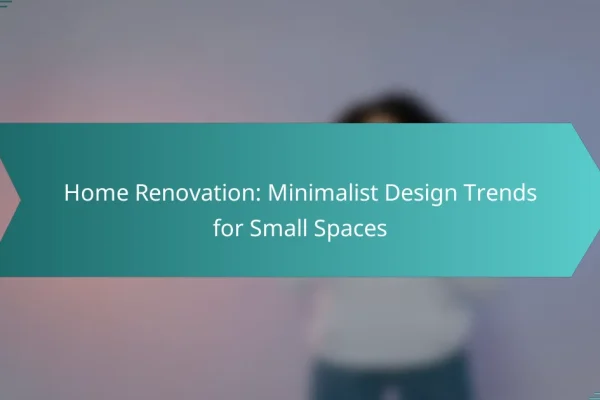What are the latest home renovation design trends in the UK?
The latest home renovation design trends in the UK focus on creating functional, sustainable, and aesthetically pleasing spaces. Key trends include open-concept living, biophilic design, smart technology integration, bold colors, and eco-friendly materials.
Open-concept living spaces
Open-concept living spaces have gained immense popularity as they promote a sense of spaciousness and enhance social interaction. By removing walls between the kitchen, dining, and living areas, homeowners can create a fluid layout that is ideal for both entertaining and family life.
When designing an open-concept space, consider the flow of natural light and how furniture placement can define different areas. Use rugs or lighting to create visual boundaries without sacrificing openness.
Biophilic design elements
Biophilic design incorporates natural elements into home interiors, aiming to connect occupants with nature. This trend includes features like indoor plants, natural materials, and large windows that invite outdoor views.
To implement biophilic design, choose materials such as wood, stone, and natural fibers. Incorporating greenery through potted plants or living walls can improve air quality and enhance well-being.
Smart home technology integration
Smart home technology is increasingly integrated into renovations, allowing homeowners to control lighting, heating, and security systems remotely. This trend enhances convenience and energy efficiency.
Consider installing smart thermostats, automated lighting systems, and security cameras that can be managed via smartphone apps. Ensure compatibility with existing systems and prioritize user-friendly interfaces.
Bold color palettes
Bold color palettes are making a statement in home renovations, moving away from neutral tones to vibrant hues that reflect personal style. Rich colors can add depth and character to any room.
When selecting colors, consider the mood you want to create. Deep blues, greens, and warm earth tones can evoke a sense of calm, while bright yellows and reds can energize a space. Use accent walls or colorful furnishings to introduce these shades without overwhelming the decor.
Eco-friendly materials
Eco-friendly materials are becoming a priority in home renovations, reflecting a growing awareness of sustainability. Options include reclaimed wood, recycled materials, and low-VOC paints that minimize environmental impact.
When choosing materials, look for certifications that indicate sustainability, such as FSC for wood products. Investing in eco-friendly options may have a higher upfront cost but can lead to long-term savings through energy efficiency and durability.
How can I incorporate sustainable practices in home renovations?
Incorporating sustainable practices in home renovations involves using eco-friendly materials and energy-efficient solutions to minimize environmental impact. Key strategies include selecting reclaimed materials, installing energy-efficient appliances, and opting for low-VOC paints.
Use reclaimed materials
Using reclaimed materials helps reduce waste and the demand for new resources. These materials can include reclaimed wood, bricks, or fixtures sourced from deconstructed buildings. Not only do they add character to your home, but they also often come at a lower cost than new materials.
When selecting reclaimed items, ensure they meet safety standards and are suitable for your intended use. Consider local suppliers or salvage yards to find unique pieces that fit your renovation style.
Install energy-efficient appliances
Energy-efficient appliances consume less electricity and water, leading to lower utility bills and a reduced carbon footprint. Look for appliances with the ENERGY STAR label, which indicates they meet strict efficiency guidelines set by the U.S. Environmental Protection Agency.
When upgrading, consider the long-term savings on energy costs versus the initial investment. Many energy-efficient models offer rebates or tax incentives, making them more affordable in the long run.
Choose low-VOC paints
Low-VOC (volatile organic compound) paints are a healthier option for your home as they emit fewer harmful chemicals into the air. These paints are available in various colors and finishes, allowing you to achieve your desired aesthetic without compromising indoor air quality.
When selecting low-VOC paints, check for certifications such as Green Seal or GREENGUARD, which ensure the products meet stringent environmental standards. This choice not only benefits your health but also contributes to a more sustainable renovation overall.
What are the costs associated with home renovation in major UK cities?
The costs of home renovation in major UK cities can vary significantly based on location, project scope, and materials used. Generally, homeowners should expect to budget anywhere from a few thousand to tens of thousands of pounds, depending on the extent of the renovations.
London renovation costs
In London, renovation costs are among the highest in the UK. Homeowners can expect to pay between £1,500 and £2,500 per square meter for comprehensive renovations, which can include kitchen and bathroom upgrades, extensions, and structural changes.
Factors such as the type of property, its location within the city, and the quality of materials can influence the final cost. It’s advisable to obtain multiple quotes from contractors to ensure competitive pricing.
Birmingham renovation costs
Birmingham offers more affordable renovation options compared to London, with costs typically ranging from £1,200 to £1,800 per square meter. This makes it an attractive choice for homeowners looking to upgrade their properties without breaking the bank.
When planning a renovation in Birmingham, consider local regulations and planning permissions, especially for larger projects. Engaging with local contractors can also provide insights into cost-effective materials and design options.
Manchester renovation costs
In Manchester, renovation costs generally fall between £1,100 and £1,700 per square meter. The city’s growing popularity has led to an increase in renovation projects, making it essential to plan and budget carefully.
Homeowners should be aware of potential additional costs, such as permits and inspections, which can vary by project size. Collaborating with experienced local builders can help streamline the process and ensure compliance with local building standards.
What are the key factors to consider when planning a home renovation?
When planning a home renovation, it’s essential to consider budget constraints, timeline for completion, and design style preferences. These factors will significantly influence the overall success and satisfaction with your renovation project.
Budget constraints
Establishing a clear budget is crucial for any home renovation. Determine how much you can afford to spend, including a buffer for unexpected costs, which typically range from 10-20% of the total budget. This will help you make informed decisions about materials, labor, and design choices.
Consider breaking down your budget into categories such as materials, labor, permits, and furnishings. This can help you prioritize spending and identify areas where you might cut costs, such as opting for less expensive materials or doing some work yourself.
Timeline for completion
Setting a realistic timeline for your renovation is vital to keep the project on track. Consider factors such as the scope of work, availability of contractors, and potential delays due to weather or supply chain issues. A typical renovation can take anywhere from a few weeks to several months, depending on complexity.
To manage your timeline effectively, create a detailed schedule outlining each phase of the renovation. Regularly review progress and adjust timelines as needed to ensure the project stays on course. Be prepared for potential setbacks and maintain flexibility in your planning.
Design style preferences
Your design style preferences will guide many decisions throughout the renovation process. Take time to research various styles, such as modern, traditional, or industrial, and consider how they align with your lifestyle and the existing architecture of your home.
Gather inspiration from magazines, websites, or social media platforms to help clarify your vision. Once you have a clear idea of your preferred style, communicate this to your designer or contractor to ensure that the final result reflects your tastes and meets your functional needs.
How do I choose the right contractor for my renovation project?
Choosing the right contractor for your renovation project involves thorough research and careful consideration of their qualifications and reputation. Start by identifying contractors who specialize in the type of renovation you need, and then evaluate their experience, reviews, and references.
Check references and reviews
Checking references and reviews is crucial in selecting a reliable contractor. Look for online reviews on platforms like Google, Yelp, or specialized home improvement sites to gauge customer satisfaction. Pay attention to both positive and negative feedback to get a balanced view.
Ask potential contractors for references from previous clients. Contact these references to inquire about their experiences, the quality of work, adherence to timelines, and overall satisfaction. This direct feedback can provide valuable insights into what you can expect.
Consider the contractor’s portfolio as well. Reviewing past projects can help you assess their style and quality of work. Ensure that their previous renovations align with your vision and standards, which can be a strong indicator of their capability to handle your project effectively.












